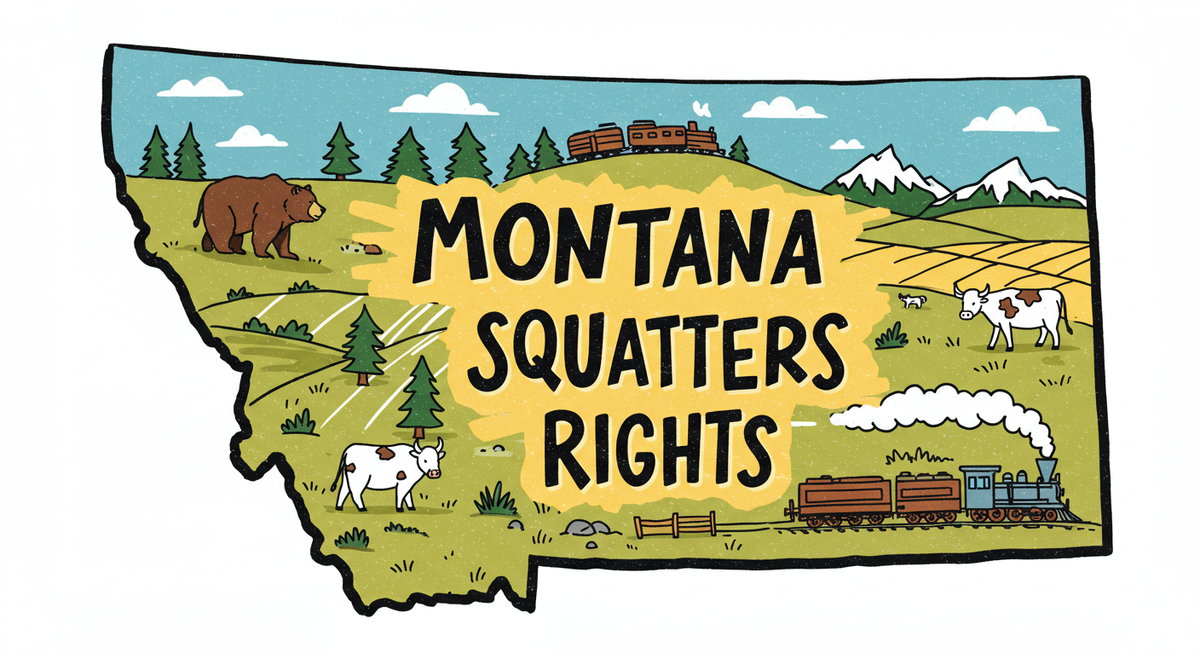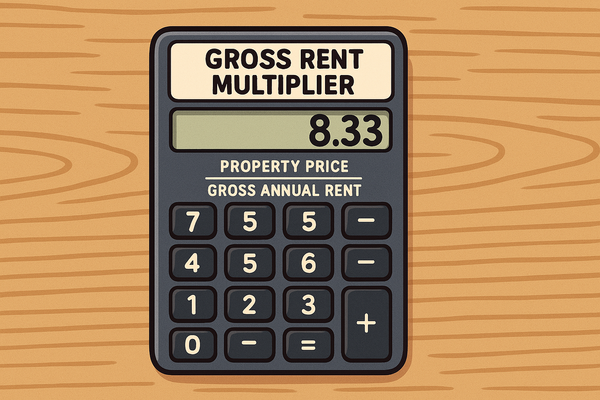Montana Squatters Rights Guide: Understanding Adverse Possession Laws
What makes Montana unique is that while the state has a relatively short 5-year statutory period, the additional requirement to pay property taxes on the claimed land creates a significant practical barrier.

Montana's approach to squatters' rights and adverse possession is uniquely strict among U.S. states, creating what legal experts call the "Montana Paradox" - a system where adverse possession is technically possible but practically almost impossible to achieve.
This comprehensive guide explores Montana's legal framework, requirements, and processes for property owners concerned about squatters and adverse possession claims.
Key Takeaways
- Montana requires just 5 years of continuous occupation for adverse possession, but mandates payment of all property taxes during this period
- Montana's Attorney General has described adverse possession as "functionally impossible" in the state due to the tax payment requirement
- Recent high-profile squatter cases have led to proposed legislation strengthening property owners' rights
- Montana property owners must follow specific legal procedures to remove squatters, as self-help eviction is illegal
- Regular property monitoring and documentation are essential preventative measures
Difference Between Squatters & Trespassers
Squatters are individuals who occupy property without legal ownership or permission, while trespassers are individuals who unlawfully enter but don't establish residence.
Adverse Possession as Defined in Montana
Adverse possession in Montana refers to the legal process by which a squatter can potentially claim ownership of property after meeting specific requirements (as detailed in this article).
Historically, adverse possession laws were created to encourage land development and productive use of property.
Squatter Snippet: Real Cases from Montana
In 2023, Montana real estate agent Alyssa Webb encountered a cigarette-smoking squatter during a virtual home showing in Billings. Webb fled the property in terror after discovering the hidden occupant, and the incident went viral with approximately 7 million views on TikTok. This high-profile case highlighted the ongoing issues with squatters in Montana and contributed to renewed discussions about strengthening the state's laws against illegal occupancy.
Another notable case involves Alan Rice, a commercial property owner in Billings who faced a two-year battle with an alleged "serial squatter." The tenant stopped paying rent but refused to leave, instead filing a lawsuit claiming the building was unsafe. This legal maneuver effectively stalled eviction proceedings for years, demonstrating how Montana's legal system can sometimes inadvertently protect those exploiting loopholes in the law.
Key Timeline: Statutory Period in Montana
- Required occupation period: 5 years in Montana
- Continuous possession requirement: Occupation without significant gaps for the entire 5-year period
- Comparison with neighboring states:
- North Dakota: 20 years
- South Dakota: 20 years
- Wyoming: 10 years
- Timeline exceptions:
- Military service may toll the statutory period
- Legal incompetence/disability may extend the period
CHART: Adverse Possession Timeline Comparison
| State | Required Years | Special Conditions |
|---|---|---|
| Montana | 5 years | Payment of all property taxes required |
| North Dakota | 20 years | Color of title reduces to 10 years |
| South Dakota | 20 years | Payment of taxes may be considered |
| Wyoming | 10 years | Payment of taxes required for 10 years |
Quick Guide for Property Owners
Montana's approach to adverse possession is considered "functionally impossible" according to Montana Attorney General Austin Knudsen, who has explicitly "mocked 'Blue states' for their liberal laws" regarding squatters' rights.
What makes Montana unique is that while the state has a relatively short 5-year statutory period, the additional requirement to pay property taxes on the claimed land creates a significant practical barrier that few, if any, adverse possession claims can overcome.
Despite having statutes that outline the process for adverse possession, the practical requirements make successful claims virtually impossible, creating what legal experts call the "Montana Paradox."
- Know your timeline: Squatters can only claim rights after 5 years of continuous occupation AND payment of all property taxes
- Documentation matters: Keep property records, tax receipts, and inspection logs to prove ownership
- Regular monitoring required: Vacant properties and seasonal properties are most vulnerable to squatters
- Legal obligation: Self-help eviction methods are illegal in Montana; only law enforcement can physically remove squatters
- Act quickly: The faster you address squatters, the easier the removal process
- Proper notices: Follow legal procedures when removing unauthorized occupants to avoid legal complications
Prevention: Protecting Your Property
Montana property owners have a significant advantage in protecting against adverse possession claims due to the state's strict requirements, particularly the tax payment mandate.
However, vigilance remains essential, especially given recent high-profile cases like the 2023 incident in Billings where a real estate agent discovered a squatter during a virtual home showing. Even with Montana's stringent laws, preventing squatters is always preferable to removing them through legal processes.
- Regular inspections:
- Visit property at least quarterly
- Document each visit with photos/notes
- Pay special attention to seasonal properties or vacant land
- Effective security measures:
- Secure all entry points with quality locks
- Consider alarm systems with remote monitoring
- Install motion-activated lighting and cameras
- Clear signage:
- Post "No Trespassing" signs visibly around the property
- Mark property boundaries clearly with fencing where practical
- Property management options:
- Hire professional management for vacant properties
- Consider short-term rental options for long-term vacancies
- Documentation practices:
- Keep tax payment records organized and accessible
- Maintain utility connections or monitor disconnected utilities
- Take dated photographs of property regularly
CHART: Property Risk Assessment Matrix
| Property Type | Risk Level | Recommended Prevention | Estimated Cost |
|---|---|---|---|
| Vacant Land | High | Regular inspections, boundary markers, posted signs | $500-$1000 |
| Abandoned Building | High | Security system, regular drive-bys, secure all entrances | $1000-$3000 |
| Seasonal Property | Medium | Caretaker checks, security system, neighborhood watch | $500-$2000 |
| Investment Property | Low-Medium | Professional property management, tenant screening | $800-$2500 |
Removing Squatters: Step-by-Step Process
Montana has a structured legal process for removing squatters from property, with recent legislation (Senate Bill 101) proposed in January 2025 to strengthen laws addressing squatting on private property. This bill seeks to establish criminal offenses for unlawful squatting, create a specific process for squatter removal, and add liability protections for law enforcement when removing violators. Montana's eviction process is governed by Montana Code Annotated (MCA) Title 70, Chapter 27, which outlines the specific steps property owners must take.
- Document the situation:
- Take photos/video of occupation
- Gather ownership documents including deed and tax records
- Document any property damage or alterations
- Issue proper written notice to vacate
- Use the appropriate notice form based on the situation
- Serve notice according to Montana law requirements
- File appropriate legal complaint:
- File an unlawful detainer action in Montana district court
- Include all required documentation proving ownership
- Pay the required filing fee
- Attend court hearing
- Present evidence of ownership and unauthorized occupation
- Respond to any counterclaims by the squatter
- If successful, obtain order of restitution/eviction
- The court will issue a writ of possession
- Submit the writ to the sheriff's office
- Sheriff enforces removal, not property owner
- Only the sheriff can physically remove the squatter
- Property owner must not attempt self-help eviction
- What NOT to do:
These are considered forms of "self-help evictions" which are illegal in the state of Montana.
- Do not change locks yourself while squatter is in possession
- Do not shut off utilities to force the squatter out
- Do not remove squatter's belongings without court order
- Do not threaten or intimidate the squatter
- Do not use physical force to remove the squatter
- Timeline expectations:
- Notice period: Typically 3-5 days
- Court processing: 2-4 weeks depending on court schedule
- Eviction enforcement: 3-7 days after judgment
CHART: Eviction Process Timeline
Montana's eviction timeline is governed by Montana Code Annotated § 70-27, which establishes the procedures and timelines for removing unauthorized occupants. The Montana Supreme Court has upheld strict adherence to these timelines in several cases, emphasizing that property owners must follow proper legal channels.
According to data from the Montana Legal Services Association, the average eviction process takes approximately 4-6 weeks from initial notice to physical removal, though this can vary by county and court caseload.
[Discovery of Squatter] → [Documentation: 1-2 days] → [Notice to Vacate: 3-5 days] →
[Court Filing: 1 day] → [Waiting for Hearing: 2-4 weeks] → [Court Hearing: 1 day] →
[If successful, Wait for Order: 1-3 days] → [Sheriff Enforcement: 3-7 days] → [Property Returned]
Total estimated timeline: 3-7 weeks
Legal Requirements for Adverse Possession
Montana's interpretation of adverse possession requirements is notably strict, primarily due to the tax payment requirement found in Montana Code Annotated § 70-19-411. This statute explicitly states that adverse possession cannot be established unless the claimant has "paid all the taxes, state, county, or municipal, which have been legally levied and assessed upon said land" for the entire statutory period.
Montana courts have consistently enforced this requirement, making it extraordinarily difficult for adverse possession claims to succeed.
The Montana Supreme Court has reinforced this standard in multiple cases, including Nott v. Booke (1979), which established that legal descriptions, not actual usage patterns such as fence placement, determine what taxes a person pays.
- Hostile Claim
- Requires use without the owner's permission
- Not based on ill will but on objective use without right
- Montana follows the "objective" standard of hostile possession
- Actual Possession
- Physical occupation of the property
- Using the land as a typical owner would
- Evidence may include maintenance, improvements, or regular use
- Open and Notorious Possession
- Possession must be visible and apparent
- Community should be aware of the occupation
- Secret occupation does not qualify
- Exclusive Possession
- Sole control of the property
- Not shared with the true owner or public
- Must exclude others from the property
- Continuous Possession
- Uninterrupted use for 5 years
- Seasonal use may qualify if consistent with how an owner would use it
- Any significant gaps restart the statutory period
CHART: Adverse Possession Requirements Matrix
| Requirement | Required in Montana? | Evidence Courts Accept | Common Pitfalls |
|---|---|---|---|
| Hostile Claim | Yes | Use without permission, claiming as owner | Having permission or a lease agreement |
| Actual Possession | Yes | Building structures, maintaining land | Occasional or recreational use only |
| Open & Notorious | Yes | Visible occupation, community awareness | Hidden or secretive occupation |
| Exclusive | Yes | Fencing, posting signs, excluding others | Sharing use with owners or public |
| Continuous | Yes | 5 years without interruption | Leaving and returning, sporadic use |
| Tax Payment | Yes - Critical | Proof of paying all property taxes | Inability to pay taxes on specific parcel |
Frequently Asked Questions
- "Can I remove squatters myself in Montana?"
- No, self-help eviction is illegal in Montana
- Only the sheriff can physically remove squatters after court order
- "Do squatters have to pay property taxes in Montana?"
- Yes, payment of all property taxes for 5 years is required for adverse possession
- This requirement makes adverse possession "functionally impossible" according to Montana's Attorney General
- "What's the difference between a squatter and a trespasser in Montana?"
- Trespassers: Short-term unauthorized presence, can be removed by police
- Squatters: Claim residential rights, require formal eviction process
- "Who should I contact first in Montana - police or sheriff?"
- For immediate trespassing: Police
- For established squatters: Sheriff's office for eviction enforcement
- "Can squatters claim abandoned property in Montana?"
- Technically yes, but only after 5 years AND paying all property taxes
- In practice, this is extremely rare due to the tax payment requirement
- "How quickly can I evict a squatter in Montana?"
- Typical timeline: 3-7 weeks from start to finish
- Factors affecting timeline: court scheduling, squatter response, sheriff availability
CHART: Decision Tree for Property Owners
Montana property owners facing unauthorized occupants should understand the distinction between criminal trespass and civil squatting situations. Under Montana law, law enforcement can immediately remove trespassers, but squatters who have established residence require the formal eviction process.
According to the Montana Landlords Association, some sheriff's departments are more proactive than others in assisting with squatter removal, which can impact your strategy.
The Montana Department of Justice recommends contacting law enforcement immediately upon discovering unauthorized occupants to determine the appropriate response.
Discovered Someone on Your Property
├── Emergency/Dangerous Situation? → Yes → Call Police
│ └── No ↓
├── Recent Entry (Less than 24 hours)? → Yes → Call Police (Trespasser)
│ └── No ↓
├── Evidence of Established Occupation? → Yes → Legal Eviction Process Required
│ └── No ↓
└── Uncertain Situation → Consult Attorney Before Taking Action
Recent Legislative Changes in Montana
Montana's approach to squatters and adverse possession has seen significant legislative attention in recent years, with lawmakers working to strengthen protections for property owners.
In January 2025, Senate Bill 101 was proposed to create a framework for squatter removal by establishing criminal offenses for unlawful squatting, creating a specific process for removal, adding liability protections for law enforcement, and creating penalties for providing false testimony about lease or tenant agreements.
Additionally, Senate Bill 499 (2023 Regular Session) attempted to "Revise adverse possession laws relating to certain land and improvements" but was ultimately vetoed on June 16, 2023.
- Recently Passed Laws:
- Pending Senate Bill 101 (2025): Would criminalize unlawful squatting and create formal removal process
- Impact on property owners: Would provide clearer legal remedies and faster removal options
- Effective date: Pending legislative approval
- Pending Legislation:
- Potential follow-up legislation to the vetoed Senate Bill 499
- Proposed changes: Further refinement of adverse possession standards
- Expected vote/implementation: Not yet scheduled
- Legislative Trends:
- Montana continues to reinforce its strong property owner protections
- Current trend is toward further restricting squatters' rights and strengthening enforcement mechanisms
State-Specific Considerations
- Color of Title in Montana:
- Definition: Document that appears to give ownership but has legal defects
- Impact on statutory period: No reduction of the 5-year requirement
- Still requires tax payment for full statutory period
- Burden of proof requirements:
- Squatter must prove all elements of adverse possession by clear and convincing evidence
- Tax payment requirement creates nearly insurmountable barrier
- Recent legal developments:
- Proposed Senate Bill 101 (2025) to strengthen anti-squatting laws
- Growing emphasis on law enforcement assistance in squatter removal
- How Montana differs from neighboring states:
- Much shorter statutory period (5 years vs. 20 years in the Dakotas)
- Strict tax payment requirement not found in some neighboring states
- Among the strictest adverse possession laws in the United States
CHART: Montana vs. Neighboring States Comparison
| Factor | Montana | North Dakota | South Dakota | Wyoming |
|---|---|---|---|---|
| Statutory Period | 5 years | 20 years | 20 years | 10 years |
| Color of Title Impact | None | Reduces to 10 years | None | None |
| Tax Payment Required | Yes | No | No | Yes |
| Special Conditions | Must pay all taxes | None | None | Must pay taxes |
| Strictness Rating | 5/5 | 3/5 | 3/5 | 4/5 |
Advanced Legal Process
- Court proceedings follow Montana Rules of Civil Procedure
- Evidence requirements include proof of ownership, documentation of unauthorized occupation
- Potential outcomes include eviction, monetary damages for property harm
- Appeals must be filed within 10 days of judgment
- Impact on property title can be addressed through quiet title action
- Special provisions exist for legally incompetent individuals and heirs
Real-World Examples
- Alan Rice's two-year battle with a "serial squatter" in Billings commercial property
- Alyssa Webb's viral encounter with a squatter during a virtual home showing
Resources
- Current Montana Squatters Rights Laws:
- Montana Code Annotated § 70-19-411
- Last updated: 2024
- Recent/Pending Legislation:
- Montana Senate Bill 101 (2025)
- Bill status: In committee
Legal Disclaimer
DISCLAIMER: The information provided in this guide is for general informational purposes only and should not be construed as legal advice on any subject matter. The content contained herein does not establish an attorney-client relationship.
This guide about Montana squatters' rights and adverse possession laws is intended to provide general information and should not be relied upon as legal advice. Laws and regulations regarding property rights, adverse possession, and eviction procedures vary by jurisdiction and may change over time. The information presented here may not reflect the most current legal developments or address your specific situation.
No reader should act or refrain from acting based on information in this guide without first seeking professional legal advice. Property owners dealing with squatters should consult with a qualified attorney licensed to practice in Montana for advice tailored to their particular circumstances.
The authors, publishers, and distributors of this guide expressly disclaim all liability in respect to actions taken or not taken based on any or all of the contents of this document. They shall not be responsible for any errors or omissions in this information or any consequences arising from its use.
This guide is provided "as is" without warranty of any kind, either express or implied, including but not limited to implied warranties of merchantability, fitness for a particular purpose, or non-infringement.
Copyright © 2025. All rights reserved.





